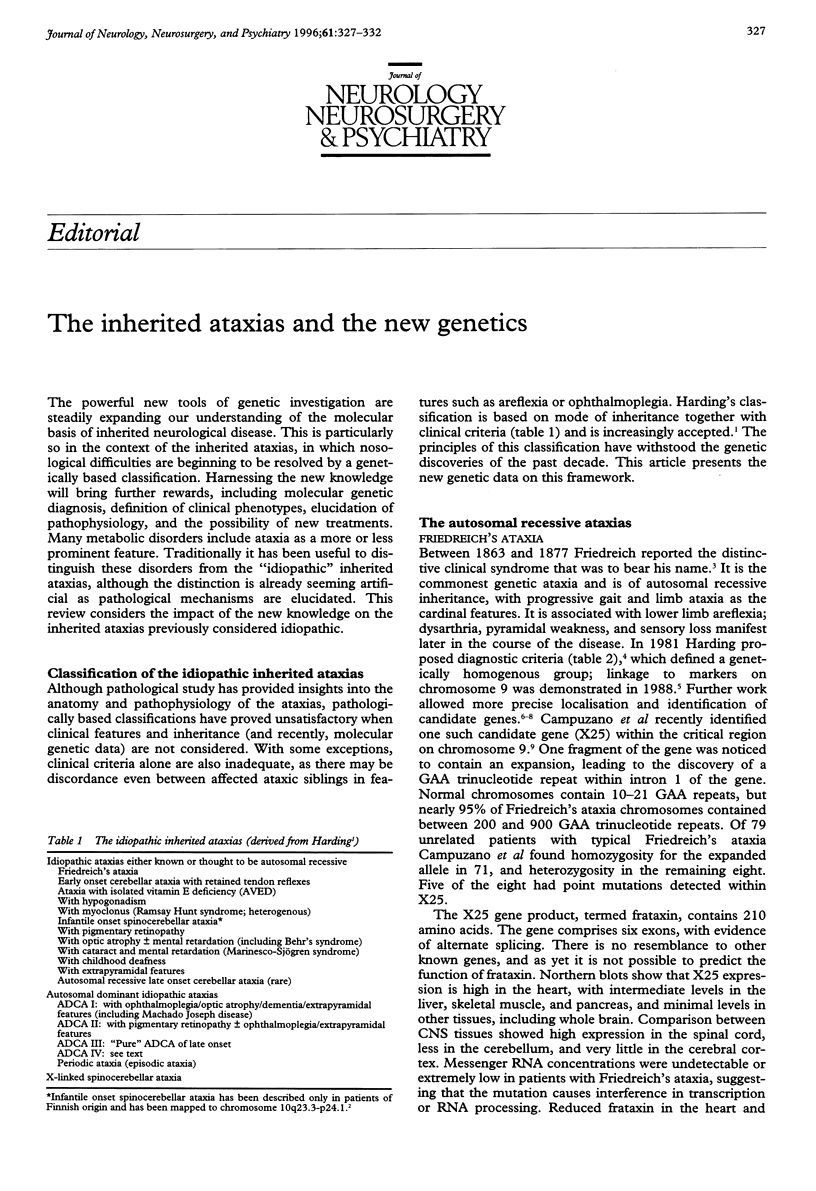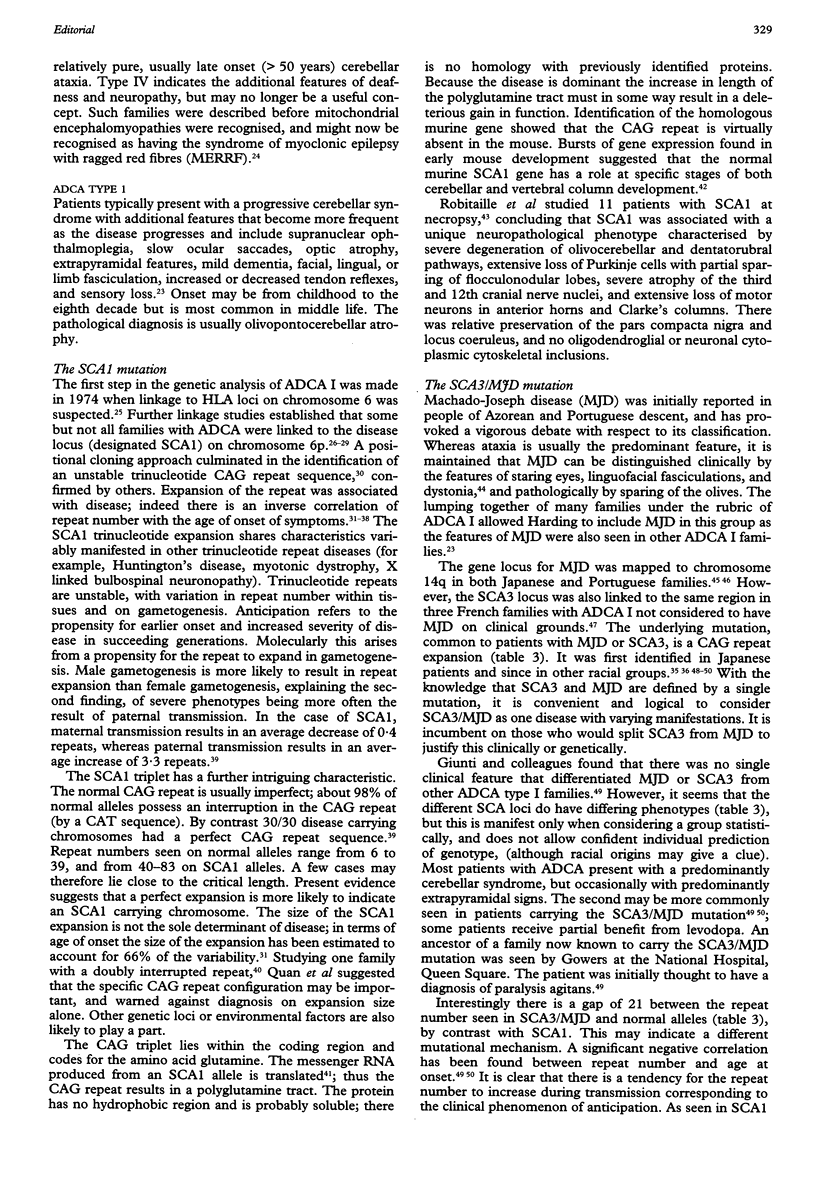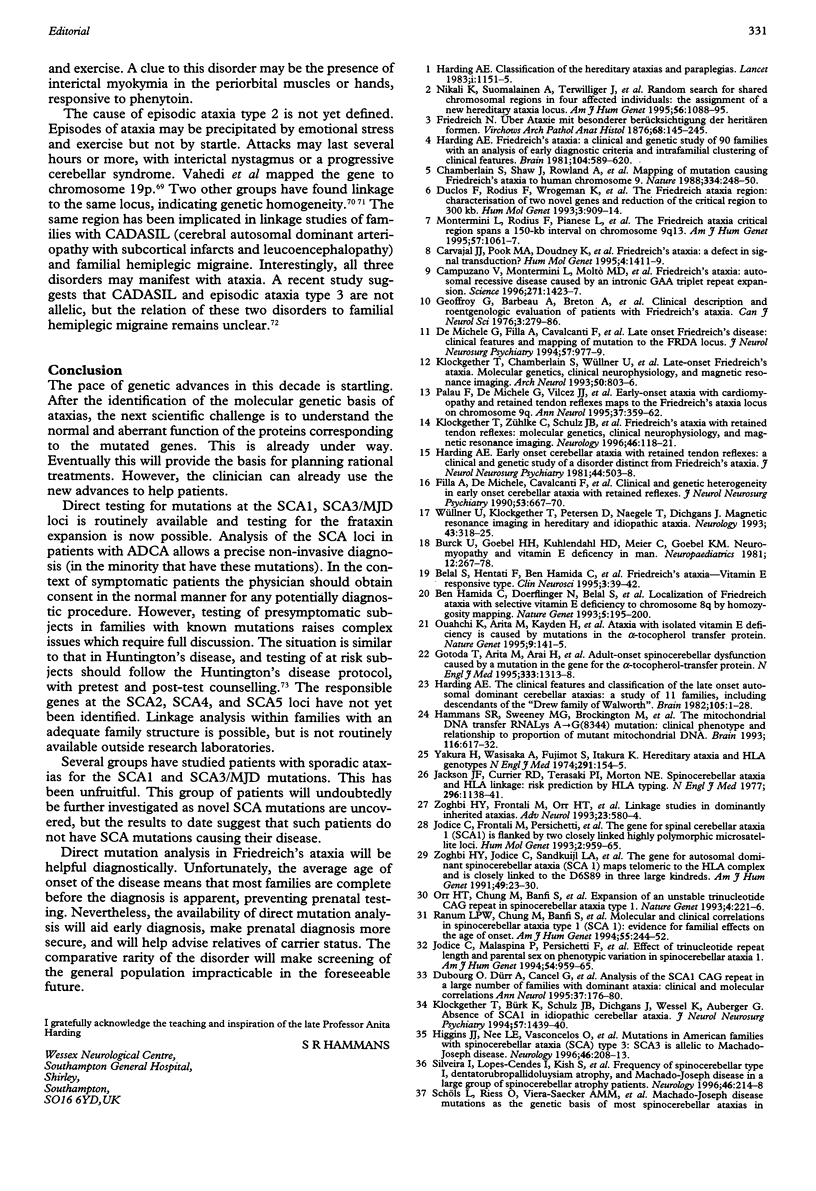Full text
PDF





Selected References
These references are in PubMed. This may not be the complete list of references from this article.
- Banfi S., Servadio A., Chung M. Y., Kwiatkowski T. J., Jr, McCall A. E., Duvick L. A., Shen Y., Roth E. J., Orr H. T., Zoghbi H. Y. Identification and characterization of the gene causing type 1 spinocerebellar ataxia. Nat Genet. 1994 Aug;7(4):513–520. doi: 10.1038/ng0894-513. [DOI] [PubMed] [Google Scholar]
- Banfi S., Servadio A., Chung M., Capozzoli F., Duvick L. A., Elde R., Zoghbi H. Y., Orr H. T. Cloning and developmental expression analysis of the murine homolog of the spinocerebellar ataxia type 1 gene (Sca1). Hum Mol Genet. 1996 Jan;5(1):33–40. doi: 10.1093/hmg/5.1.33. [DOI] [PubMed] [Google Scholar]
- Belal S., Hentati F., Ben Hamida C., Ben Hamida M. Friedreich's ataxia-vitamin E responsive type. The chromosome 8 locus. Clin Neurosci. 1995;3(1):39–42. [PubMed] [Google Scholar]
- Ben Hamida C., Doerflinger N., Belal S., Linder C., Reutenauer L., Dib C., Gyapay G., Vignal A., Le Paslier D., Cohen D. Localization of Friedreich ataxia phenotype with selective vitamin E deficiency to chromosome 8q by homozygosity mapping. Nat Genet. 1993 Oct;5(2):195–200. doi: 10.1038/ng1093-195. [DOI] [PubMed] [Google Scholar]
- Benomar A., Krols L., Stevanin G., Cancel G., LeGuern E., David G., Ouhabi H., Martin J. J., Dürr A., Zaim A. The gene for autosomal dominant cerebellar ataxia with pigmentary macular dystrophy maps to chromosome 3p12-p21.1. Nat Genet. 1995 May;10(1):84–88. doi: 10.1038/ng0595-84. [DOI] [PubMed] [Google Scholar]
- Browne D. L., Gancher S. T., Nutt J. G., Brunt E. R., Smith E. A., Kramer P., Litt M. Episodic ataxia/myokymia syndrome is associated with point mutations in the human potassium channel gene, KCNA1. Nat Genet. 1994 Oct;8(2):136–140. doi: 10.1038/ng1094-136. [DOI] [PubMed] [Google Scholar]
- Burck U., Goebel H. H., Kuhlendahl H. D., Meier C., Goebel K. M. Neuromyopathy and vitamin E deficiency in man. Neuropediatrics. 1981 Aug;12(3):267–278. doi: 10.1055/s-2008-1059657. [DOI] [PubMed] [Google Scholar]
- Campuzano V., Montermini L., Moltò M. D., Pianese L., Cossée M., Cavalcanti F., Monros E., Rodius F., Duclos F., Monticelli A. Friedreich's ataxia: autosomal recessive disease caused by an intronic GAA triplet repeat expansion. Science. 1996 Mar 8;271(5254):1423–1427. doi: 10.1126/science.271.5254.1423. [DOI] [PubMed] [Google Scholar]
- Carvajal J. J., Pook M. A., Doudney K., Hillermann R., Wilkes D., al-Mahdawi S., Williamson R., Chamberlain S. Friedreich's ataxia: a defect in signal transduction? Hum Mol Genet. 1995 Aug;4(8):1411–1419. doi: 10.1093/hmg/4.8.1411. [DOI] [PubMed] [Google Scholar]
- Chamberlain S., Shaw J., Rowland A., Wallis J., South S., Nakamura Y., von Gabain A., Farrall M., Williamson R. Mapping of mutation causing Friedreich's ataxia to human chromosome 9. Nature. 1988 Jul 21;334(6179):248–250. doi: 10.1038/334248a0. [DOI] [PubMed] [Google Scholar]
- Chung M. Y., Ranum L. P., Duvick L. A., Servadio A., Zoghbi H. Y., Orr H. T. Evidence for a mechanism predisposing to intergenerational CAG repeat instability in spinocerebellar ataxia type I. Nat Genet. 1993 Nov;5(3):254–258. doi: 10.1038/ng1193-254. [DOI] [PubMed] [Google Scholar]
- De Michele G., Filla A., Cavalcanti F., Di Maio L., Pianese L., Castaldo I., Calabrese O., Monticelli A., Varrone S., Campanella G. Late onset Friedreich's disease: clinical features and mapping of mutation to the FRDA locus. J Neurol Neurosurg Psychiatry. 1994 Aug;57(8):977–979. doi: 10.1136/jnnp.57.8.977. [DOI] [PMC free article] [PubMed] [Google Scholar]
- Dubourg O., Dürr A., Cancel G., Stevanin G., Chneiweiss H., Penet C., Agid Y., Brice A. Analysis of the SCA1 CAG repeat in a large number of families with dominant ataxia: clinical and molecular correlations. Ann Neurol. 1995 Feb;37(2):176–180. doi: 10.1002/ana.410370207. [DOI] [PubMed] [Google Scholar]
- Duclos F., Rodius F., Wrogemann K., Mandel J. L., Koenig M. The Friedreich ataxia region: characterization of two novel genes and reduction of the critical region to 300 kb. Hum Mol Genet. 1994 Jun;3(6):909–914. doi: 10.1093/hmg/3.6.909. [DOI] [PubMed] [Google Scholar]
- Ducros A., Nagy T., Alamowitch S., Nibbio A., Joutel A., Vahedi K., Chabriat H., Iba-Zizen M. T., Julien J., Davous P. Cerebral autosomal dominant arteriopathy with subcortical infarcts and leukoencephalopathy, genetic homogeneity, and mapping of the locus within a 2-cM interval. Am J Hum Genet. 1996 Jan;58(1):171–181. [PMC free article] [PubMed] [Google Scholar]
- Dürr A., Smadja D., Cancel G., Lezin A., Stevanin G., Mikol J., Bellance R., Buisson G. G., Chneiweiss H., Dellanave J. Autosomal dominant cerebellar ataxia type I in Martinique (French West Indies). Clinical and neuropathological analysis of 53 patients from three unrelated SCA2 families. Brain. 1995 Dec;118(Pt 6):1573–1581. doi: 10.1093/brain/118.6.1573. [DOI] [PubMed] [Google Scholar]
- Dürr A., Stevanin G., Cancel G., Duyckaerts C., Abbas N., Didierjean O., Chneiweiss H., Benomar A., Lyon-Caen O., Julien J. Spinocerebellar ataxia 3 and Machado-Joseph disease: clinical, molecular, and neuropathological features. Ann Neurol. 1996 Apr;39(4):490–499. doi: 10.1002/ana.410390411. [DOI] [PubMed] [Google Scholar]
- Enevoldson T. P., Sanders M. D., Harding A. E. Autosomal dominant cerebellar ataxia with pigmentary macular dystrophy. A clinical and genetic study of eight families. Brain. 1994 Jun;117(Pt 3):445–460. doi: 10.1093/brain/117.3.445. [DOI] [PubMed] [Google Scholar]
- Filla A., De Michele G., Cavalcanti F., Perretti A., Santoro L., Barbieri F., D'Arienzo G., Campanella G. Clinical and genetic heterogeneity in early onset cerebellar ataxia with retained tendon reflexes. J Neurol Neurosurg Psychiatry. 1990 Aug;53(8):667–670. doi: 10.1136/jnnp.53.8.667. [DOI] [PMC free article] [PubMed] [Google Scholar]
- Geoffroy G., Barbeau A., Breton G., Lemieux B., Aube M., Leger C., Bouchard J. P. Clinical description and roentgenologic evaluation of patients with Friedreich's ataxia. Can J Neurol Sci. 1976 Nov;3(4):279–286. doi: 10.1017/s0317167100025464. [DOI] [PubMed] [Google Scholar]
- Gispert S., Twells R., Orozco G., Brice A., Weber J., Heredero L., Scheufler K., Riley B., Allotey R., Nothers C. Chromosomal assignment of the second locus for autosomal dominant cerebellar ataxia (SCA2) to chromosome 12q23-24.1. Nat Genet. 1993 Jul;4(3):295–299. doi: 10.1038/ng0793-295. [DOI] [PubMed] [Google Scholar]
- Giunti P., Sweeney M. G., Harding A. E. Detection of the Machado-Joseph disease/spinocerebellar ataxia three trinucleotide repeat expansion in families with autosomal dominant motor disorders, including the Drew family of Walworth. Brain. 1995 Oct;118(Pt 5):1077–1085. doi: 10.1093/brain/118.5.1077. [DOI] [PubMed] [Google Scholar]
- Giunti P., Sweeney M. G., Spadaro M., Jodice C., Novelletto A., Malaspina P., Frontali M., Harding A. E. The trinucleotide repeat expansion on chromosome 6p (SCA1) in autosomal dominant cerebellar ataxias. Brain. 1994 Aug;117(Pt 4):645–649. doi: 10.1093/brain/117.4.645. [DOI] [PubMed] [Google Scholar]
- Gotoda T., Arita M., Arai H., Inoue K., Yokota T., Fukuo Y., Yazaki Y., Yamada N. Adult-onset spinocerebellar dysfunction caused by a mutation in the gene for the alpha-tocopherol-transfer protein. N Engl J Med. 1995 Nov 16;333(20):1313–1318. doi: 10.1056/NEJM199511163332003. [DOI] [PubMed] [Google Scholar]
- Gouw L. G., Kaplan C. D., Haines J. H., Digre K. B., Rutledge S. L., Matilla A., Leppert M., Zoghbi H. Y., Ptácek L. J. Retinal degeneration characterizes a spinocerebellar ataxia mapping to chromosome 3p. Nat Genet. 1995 May;10(1):89–93. doi: 10.1038/ng0595-89. [DOI] [PubMed] [Google Scholar]
- Hammans S. R., Sweeney M. G., Brockington M., Lennox G. G., Lawton N. F., Kennedy C. R., Morgan-Hughes J. A., Harding A. E. The mitochondrial DNA transfer RNA(Lys)A-->G(8344) mutation and the syndrome of myoclonic epilepsy with ragged red fibres (MERRF). Relationship of clinical phenotype to proportion of mutant mitochondrial DNA. Brain. 1993 Jun;116(Pt 3):617–632. doi: 10.1093/brain/116.3.617. [DOI] [PubMed] [Google Scholar]
- Harding A. E. Early onset cerebellar ataxia with retained tendon reflexes: a clinical and genetic study of a disorder distinct from Friedreich's ataxia. J Neurol Neurosurg Psychiatry. 1981 Jun;44(6):503–508. doi: 10.1136/jnnp.44.6.503. [DOI] [PMC free article] [PubMed] [Google Scholar]
- Harding A. E. Friedreich's ataxia: a clinical and genetic study of 90 families with an analysis of early diagnostic criteria and intrafamilial clustering of clinical features. Brain. 1981 Sep;104(3):589–620. doi: 10.1093/brain/104.3.589. [DOI] [PubMed] [Google Scholar]
- Harding A. E. The clinical features and classification of the late onset autosomal dominant cerebellar ataxias. A study of 11 families, including descendants of the 'the Drew family of Walworth'. Brain. 1982 Mar;105(Pt 1):1–28. doi: 10.1093/brain/105.1.1. [DOI] [PubMed] [Google Scholar]
- Higgins J. J., Nee L. E., Vasconcelos O., Ide S. E., Lavedan C., Goldfarb L. G., Polymeropoulos M. H. Mutations in American families with spinocerebellar ataxia (SCA) type 3: SCA3 is allelic to Machado-Joseph disease. Neurology. 1996 Jan;46(1):208–213. doi: 10.1212/wnl.46.1.208. [DOI] [PubMed] [Google Scholar]
- Holmberg M., Johansson J., Forsgren L., Heijbel J., Sandgren O., Holmgren G. Localization of autosomal dominant cerebellar ataxia associated with retinal degeneration and anticipation to chromosome 3p12-p21.1. Hum Mol Genet. 1995 Aug;4(8):1441–1445. doi: 10.1093/hmg/4.8.1441. [DOI] [PubMed] [Google Scholar]
- Jackson J. F., Currier R. D., Terasaki P. I., Morton N. E. Spinocerebellar ataxia and HLA linkage: risk prediction by HLA typing. N Engl J Med. 1977 May 19;296(20):1138–1141. doi: 10.1056/NEJM197705192962003. [DOI] [PubMed] [Google Scholar]
- Jodice C., Malaspina P., Persichetti F., Novelletto A., Spadaro M., Giunti P., Morocutti C., Terrenato L., Harding A. E., Frontali M. Effect of trinucleotide repeat length and parental sex on phenotypic variation in spinocerebellar ataxia I. Am J Hum Genet. 1994 Jun;54(6):959–965. [PMC free article] [PubMed] [Google Scholar]
- Kawaguchi Y., Okamoto T., Taniwaki M., Aizawa M., Inoue M., Katayama S., Kawakami H., Nakamura S., Nishimura M., Akiguchi I. CAG expansions in a novel gene for Machado-Joseph disease at chromosome 14q32.1. Nat Genet. 1994 Nov;8(3):221–228. doi: 10.1038/ng1194-221. [DOI] [PubMed] [Google Scholar]
- Klockgether T., Bürk K., Schulz J. B., Dichgans J., Wessel K., Auburger G. Absence of SCA1 mutation in idiopathic cerebellar ataxia. J Neurol Neurosurg Psychiatry. 1994 Nov;57(11):1439–1440. doi: 10.1136/jnnp.57.11.1439-a. [DOI] [PMC free article] [PubMed] [Google Scholar]
- Klockgether T., Chamberlain S., Wüllner U., Fetter M., Dittmann H., Petersen D., Dichgans J. Late-onset Friedreich's ataxia. Molecular genetics, clinical neurophysiology, and magnetic resonance imaging. Arch Neurol. 1993 Aug;50(8):803–806. doi: 10.1001/archneur.1993.00540080014006. [DOI] [PubMed] [Google Scholar]
- Klockgether T., Zühlke C., Schulz J. B., Bürk K., Fetter M., Dittmann H., Skalej M., Dichgans J. Friedreich's ataxia with retained tendon reflexes: molecular genetics, clinical neurophysiology, and magnetic resonance imaging. Neurology. 1996 Jan;46(1):118–121. doi: 10.1212/wnl.46.1.118. [DOI] [PubMed] [Google Scholar]
- Koide R., Ikeuchi T., Onodera O., Tanaka H., Igarashi S., Endo K., Takahashi H., Kondo R., Ishikawa A., Hayashi T. Unstable expansion of CAG repeat in hereditary dentatorubral-pallidoluysian atrophy (DRPLA). Nat Genet. 1994 Jan;6(1):9–13. doi: 10.1038/ng0194-9. [DOI] [PubMed] [Google Scholar]
- Konigsmark B. W., Weiner L. P. The olivopontocerebellar atrophies: a review. Medicine (Baltimore) 1970 May;49(3):227–241. doi: 10.1097/00005792-197005000-00003. [DOI] [PubMed] [Google Scholar]
- Kramer P. L., Yue Q., Gancher S. T., Nutt J. G., Baloh R., Smith E., Browne D., Bussey K., Lovrien E., Nelson S. A locus for the nystagmus-associated form of episodic ataxia maps to an 11-cM region on chromosome 19p. Am J Hum Genet. 1995 Jul;57(1):182–185. [PMC free article] [PubMed] [Google Scholar]
- Maruyama H., Nakamura S., Matsuyama Z., Sakai T., Doyu M., Sobue G., Seto M., Tsujihata M., Oh-i T., Nishio T. Molecular features of the CAG repeats and clinical manifestation of Machado-Joseph disease. Hum Mol Genet. 1995 May;4(5):807–812. doi: 10.1093/hmg/4.5.807. [DOI] [PubMed] [Google Scholar]
- Matilla T., McCall A., Subramony S. H., Zoghbi H. Y. Molecular and clinical correlations in spinocerebellar ataxia type 3 and Machado-Joseph disease. Ann Neurol. 1995 Jul;38(1):68–72. doi: 10.1002/ana.410380113. [DOI] [PubMed] [Google Scholar]
- Montermini L., Rodius F., Pianese L., Moltò M. D., Cossée M., Campuzano V., Cavalcanti F., Monticelli A., Palau F., Gyapay G. The Friedreich ataxia critical region spans a 150-kb interval on chromosome 9q13. Am J Hum Genet. 1995 Nov;57(5):1061–1067. [PMC free article] [PubMed] [Google Scholar]
- Nagafuchi S., Yanagisawa H., Sato K., Shirayama T., Ohsaki E., Bundo M., Takeda T., Tadokoro K., Kondo I., Murayama N. Dentatorubral and pallidoluysian atrophy expansion of an unstable CAG trinucleotide on chromosome 12p. Nat Genet. 1994 Jan;6(1):14–18. doi: 10.1038/ng0194-14. [DOI] [PubMed] [Google Scholar]
- Nikali K., Suomalainen A., Terwilliger J., Koskinen T., Weissenbach J., Peltonen L. Random search for shared chromosomal regions in four affected individuals: the assignment of a new hereditary ataxia locus. Am J Hum Genet. 1995 May;56(5):1088–1095. [PMC free article] [PubMed] [Google Scholar]
- Orr H. T., Chung M. Y., Banfi S., Kwiatkowski T. J., Jr, Servadio A., Beaudet A. L., McCall A. E., Duvick L. A., Ranum L. P., Zoghbi H. Y. Expansion of an unstable trinucleotide CAG repeat in spinocerebellar ataxia type 1. Nat Genet. 1993 Jul;4(3):221–226. doi: 10.1038/ng0793-221. [DOI] [PubMed] [Google Scholar]
- Ouahchi K., Arita M., Kayden H., Hentati F., Ben Hamida M., Sokol R., Arai H., Inoue K., Mandel J. L., Koenig M. Ataxia with isolated vitamin E deficiency is caused by mutations in the alpha-tocopherol transfer protein. Nat Genet. 1995 Feb;9(2):141–145. doi: 10.1038/ng0295-141. [DOI] [PubMed] [Google Scholar]
- Palau F., De Michele G., Vilchez J. J., Pandolfo M., Monrós E., Cocozza S., Smeyers P., Lopez-Arlandis J., Campanella G., Di Donato S. Early-onset ataxia with cardiomyopathy and retained tendon reflexes maps to the Friedreich's ataxia locus on chromosome 9q. Ann Neurol. 1995 Mar;37(3):359–362. doi: 10.1002/ana.410370312. [DOI] [PubMed] [Google Scholar]
- Puska P., Iacono J. M., Nissinen A., Korhonen H. J., Vartianinen E., Pietinen P., Dougherty R., Leino U., Mutanen M., Moisio S. Controlled, randomised trial of the effect of dietary fat on blood pressure. Lancet. 1983 Jan 1;1(8314-5):1–5. doi: 10.1016/s0140-6736(83)91556-8. [DOI] [PubMed] [Google Scholar]
- Quan F., Janas J., Popovich B. W. A novel CAG repeat configuration in the SCA1 gene: implications for the molecular diagnostics of spinocerebellar ataxia type 1. Hum Mol Genet. 1995 Dec;4(12):2411–2413. doi: 10.1093/hmg/4.12.2411. [DOI] [PubMed] [Google Scholar]
- Ranum L. P., Chung M. Y., Banfi S., Bryer A., Schut L. J., Ramesar R., Duvick L. A., McCall A., Subramony S. H., Goldfarb L. Molecular and clinical correlations in spinocerebellar ataxia type I: evidence for familial effects on the age at onset. Am J Hum Genet. 1994 Aug;55(2):244–252. [PMC free article] [PubMed] [Google Scholar]
- Ranum L. P., Schut L. J., Lundgren J. K., Orr H. T., Livingston D. M. Spinocerebellar ataxia type 5 in a family descended from the grandparents of President Lincoln maps to chromosome 11. Nat Genet. 1994 Nov;8(3):280–284. doi: 10.1038/ng1194-280. [DOI] [PubMed] [Google Scholar]
- Robitaille Y., Schut L., Kish S. J. Structural and immunocytochemical features of olivopontocerebellar atrophy caused by the spinocerebellar ataxia type 1 (SCA-1) mutation define a unique phenotype. Acta Neuropathol. 1995;90(6):572–581. doi: 10.1007/BF00318569. [DOI] [PubMed] [Google Scholar]
- Rosenberg R. N. Machado-Joseph disease: an autosomal dominant motor system degeneration. Mov Disord. 1992;7(3):193–203. doi: 10.1002/mds.870070302. [DOI] [PubMed] [Google Scholar]
- Silveira I., Lopes-Cendes I., Kish S., Maciel P., Gaspar C., Coutinho P., Botez M. I., Teive H., Arruda W., Steiner C. E. Frequency of spinocerebellar ataxia type 1, dentatorubropallidoluysian atrophy, and Machado-Joseph disease mutations in a large group of spinocerebellar ataxia patients. Neurology. 1996 Jan;46(1):214–218. doi: 10.1212/wnl.46.1.214. [DOI] [PubMed] [Google Scholar]
- Stevanin G., Cancel G., Dürr A., Chneiweiss H., Dubourg O., Weissenbach J., Cann H. M., Agid Y., Brice A. The gene for spinal cerebellar ataxia 3 (SCA3) is located in a region of approximately 3 cM on chromosome 14q24.3-q32.2. Am J Hum Genet. 1995 Jan;56(1):193–201. [PMC free article] [PubMed] [Google Scholar]
- Sudarsky L., Coutinho P. Machado-Joseph disease. Clin Neurosci. 1995;3(1):17–22. [PubMed] [Google Scholar]
- Takiyama Y., Igarashi S., Rogaeva E. A., Endo K., Rogaev E. I., Tanaka H., Sherrington R., Sanpei K., Liang Y., Saito M. Evidence for inter-generational instability in the CAG repeat in the MJD1 gene and for conserved haplotypes at flanking markers amongst Japanese and Caucasian subjects with Machado-Joseph disease. Hum Mol Genet. 1995 Jul;4(7):1137–1146. doi: 10.1093/hmg/4.7.1137. [DOI] [PubMed] [Google Scholar]
- Takiyama Y., Nishizawa M., Tanaka H., Kawashima S., Sakamoto H., Karube Y., Shimazaki H., Soutome M., Endo K., Ohta S. The gene for Machado-Joseph disease maps to human chromosome 14q. Nat Genet. 1993 Jul;4(3):300–304. doi: 10.1038/ng0793-300. [DOI] [PubMed] [Google Scholar]
- Teh B. T., Silburn P., Lindblad K., Betz R., Boyle R., Schalling M., Larsson C. Familial periodic cerebellar ataxia without myokymia maps to a 19-cM region on 19p13. Am J Hum Genet. 1995 Jun;56(6):1443–1449. [PMC free article] [PubMed] [Google Scholar]
- Trottier Y., Lutz Y., Stevanin G., Imbert G., Devys D., Cancel G., Saudou F., Weber C., David G., Tora L. Polyglutamine expansion as a pathological epitope in Huntington's disease and four dominant cerebellar ataxias. Nature. 1995 Nov 23;378(6555):403–406. doi: 10.1038/378403a0. [DOI] [PubMed] [Google Scholar]
- Twist E. C., Casaubon L. K., Ruttledge M. H., Rao V. S., Macleod P. M., Radvany J., Zhao Z., Rosenberg R. N., Farrer L. A., Rouleau G. A. Machado Joseph disease maps to the same region of chromosome 14 as the spinocerebellar ataxia type 3 locus. J Med Genet. 1995 Jan;32(1):25–31. doi: 10.1136/jmg.32.1.25. [DOI] [PMC free article] [PubMed] [Google Scholar]
- Vahedi K., Joutel A., Van Bogaert P., Ducros A., Maciazeck J., Bach J. F., Bousser M. G., Tournier-Lasserve E. A gene for hereditary paroxysmal cerebellar ataxia maps to chromosome 19p. Ann Neurol. 1995 Mar;37(3):289–293. doi: 10.1002/ana.410370304. [DOI] [PubMed] [Google Scholar]
- Warner T. T., Williams L. D., Walker R. W., Flinter F., Robb S. A., Bundey S. E., Honavar M., Harding A. E. A clinical and molecular genetic study of dentatorubropallidoluysian atrophy in four European families. Ann Neurol. 1995 Apr;37(4):452–459. doi: 10.1002/ana.410370407. [DOI] [PubMed] [Google Scholar]
- Wüllner U., Klockgether T., Petersen D., Naegele T., Dichgans J. Magnetic resonance imaging in hereditary and idiopathic ataxia. Neurology. 1993 Feb;43(2):318–325. doi: 10.1212/wnl.43.2.318. [DOI] [PubMed] [Google Scholar]
- Yakura H., Wakisaka A., Fujimoto S., Itakura K. Letter: Hereditary ataxia and HL-A. N Engl J Med. 1974 Jul 18;291(3):154–155. doi: 10.1056/NEJM197407182910314. [DOI] [PubMed] [Google Scholar]
- Zoghbi H. Y., Jodice C., Sandkuijl L. A., Kwiatkowski T. J., Jr, McCall A. E., Huntoon S. A., Lulli P., Spadaro M., Litt M., Cann H. M. The gene for autosomal dominant spinocerebellar ataxia (SCA1) maps telomeric to the HLA complex and is closely linked to the D6S89 locus in three large kindreds. Am J Hum Genet. 1991 Jul;49(1):23–30. [PMC free article] [PubMed] [Google Scholar]


